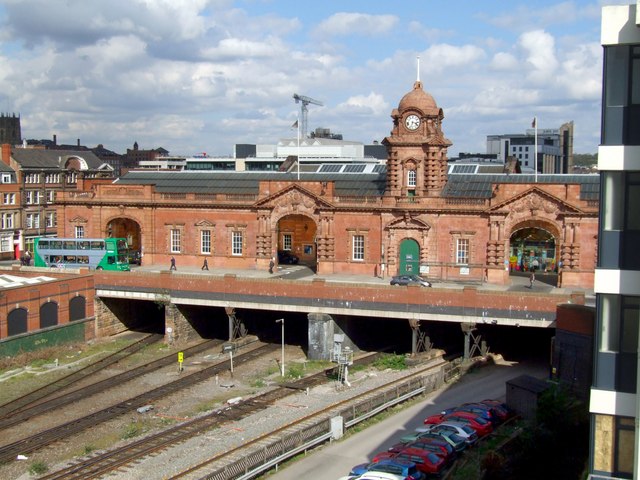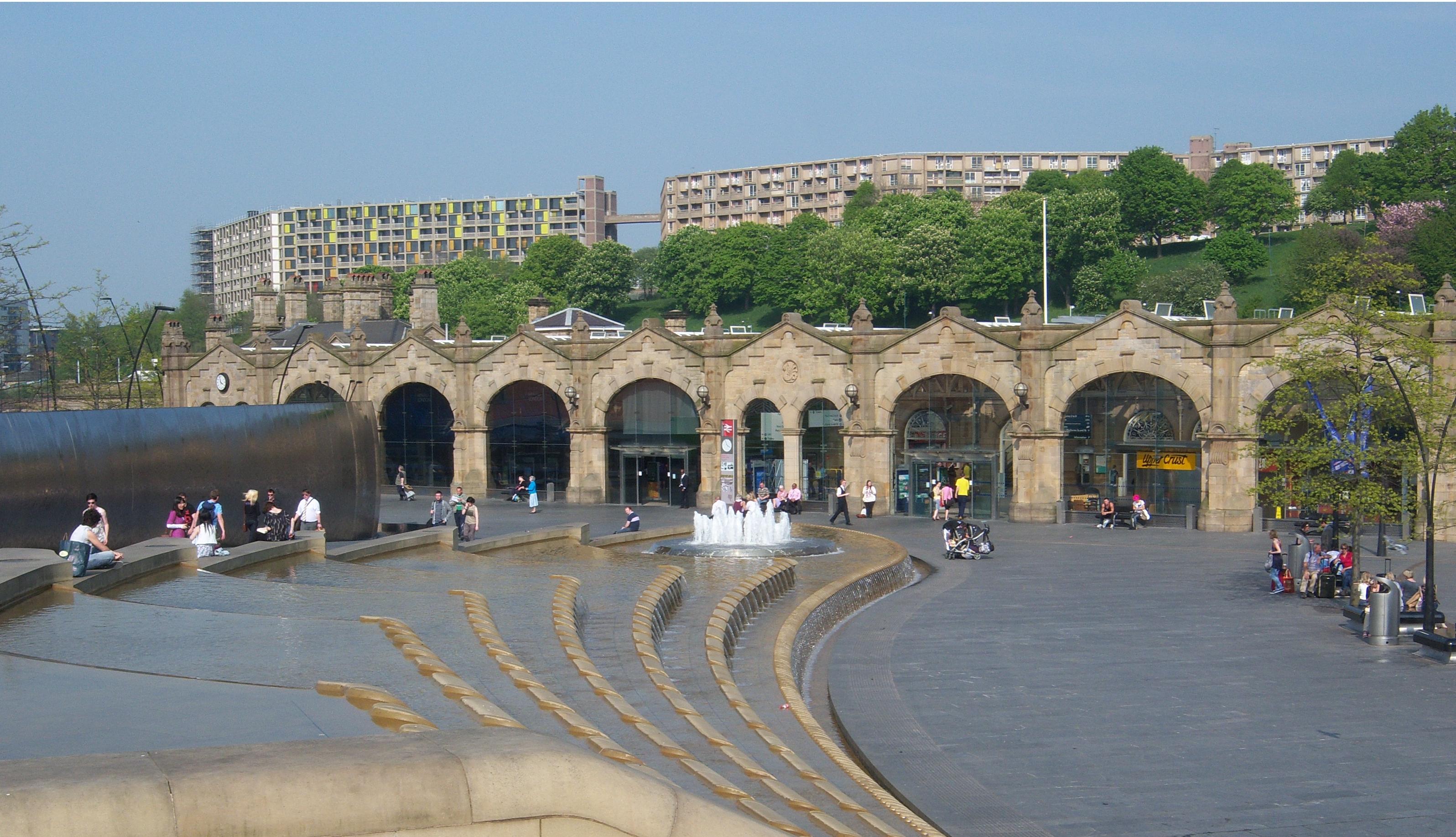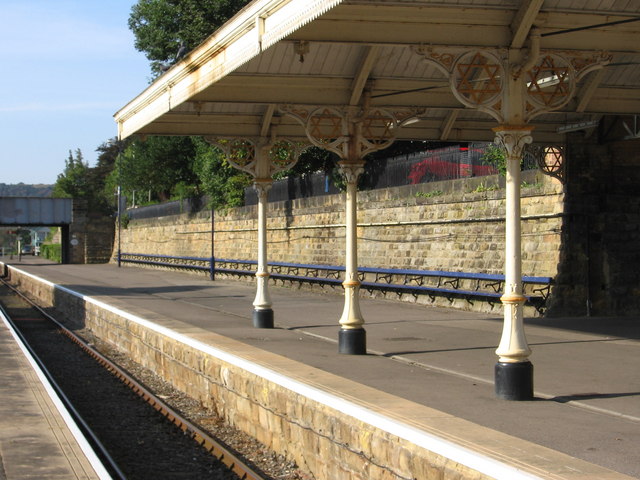|
Widnes Railway Station
Widnes railway station (formerly Widnes North) is a railway station serving the town of Widnes, Halton (borough), Halton, England. It is recorded in the National Heritage List for England as a designated Grade II Listed building#England and Wales, listed building. The station is operated by Northern Trains. History The station opened as Farnworth for Widnes on 1 August 1873 when the Cheshire Lines Committee opened the line between and to passengers. Farnworth, Cheshire, Farnworth being at the time a village over north of Widnes, but has since been absorbed to become a northern suburb of the town. The station is located where the line is bridged by Birchfield Road, now the B5419. The main station building is of the "common twin-pavilion type adopted by the CLC" with a larger, two-storey, projecting pavilion forming a house and a smaller single-storey one. Linking them is an entrance hall, ticket office and three-bay iron-arcaded waiting shelter. The building is decorated ... [...More Info...] [...Related Items...] OR: [Wikipedia] [Google] [Baidu] |
Farnworth, Cheshire
Farnworth is part of the town of Widnes which is in the Borough of Halton in the ceremonial county of Cheshire and historic county of Lancashire, England. A village between Prescot and Penketh, its name is now that of an electoral ward in the Borough of Halton with a population in 2004 of 6,300. History The name Farnworth derives from the Anglo-Saxon word ''fearn'' or fern and ''weorthig'', meaning farm or estate, and it therefore means "fern-farm". The village was established on higher ground to the north of the River Mersey and was for many years an isolated community. The earliest documentary evidence relating to the village is a charter dated 1352 when Henry, Duke of Lancaster established a halmote court for the manor of Widnes. The origins of the village are unknown. A chapel had been founded in the village about 1180 which was dedicated to St Wilfrid. At this time the village was part of the parish of Prescot. A grammar school was established in the village in 1507 by ... [...More Info...] [...Related Items...] OR: [Wikipedia] [Google] [Baidu] |
Manchester Oxford Road Railway Station
Manchester Oxford Road railway station is a railway station in Manchester, England, at the junction of Whitworth Street West and Oxford Street. It opened in 1849 and was rebuilt in 1960. It is the second busiest of the four stations in Manchester city centre. The station serves the southern part of Manchester city centre, the University of Manchester and Manchester Metropolitan University, on the line from westwards towards Warrington, Chester, Llandudno, Liverpool, and Blackpool. Eastbound trains go beyond Piccadilly to , , , , and . The station consists of four through platforms and one terminating bay platform. The station sits on a Grade II listed viaduct, which was built in 1839 as part of the Manchester, South Junction and Altrincham Railway. To reduce load on this viaduct, the station unusually utilises laminated wood structures as opposed to masonry, concrete, iron or steel. English Heritage describes it as a "building of outstanding architectural quality and technol ... [...More Info...] [...Related Items...] OR: [Wikipedia] [Google] [Baidu] |
Sankey Railway Station
Sankey railway station, also known as Sankey for Penketh, is a railway station in the west of Warrington, Cheshire, England, serving the Great Sankey, Penketh and Whittle Hall areas of the town. The station, and all trains serving it, are operated by Northern Trains. It is designated by English Heritage as a Grade II listed building. History The line through the station site opened for freight on 1 March 1873 and for passengers on 1 August 1873 when the Cheshire Lines Committee opened the line between and . The station was opened as Sankey for passengers and goods on 1 May 1874. The station is located in a cutting where the line is bridged by what is now Station Road. The main station building is of the "common twin-pavilion type adopted by the CLC" with a larger, two-storey, projecting pavilion forming a house and a smaller single-storey one. Linking them is an entrance hall, ticket office and three-bay iron-arcaded waiting shelter. The building is decorated with elabor ... [...More Info...] [...Related Items...] OR: [Wikipedia] [Google] [Baidu] |
Warrington Central Railway Station
Warrington Central railway station is one of three main railway stations serving the town of Warrington in the north-west of England. It is located on the southern route of the Liverpool to Manchester Lines (the former Cheshire Lines Committee route between Liverpool and Manchester), being situated approximately halfway between the two cities. Central station is served by diesel trains to Liverpool, Manchester, Manchester Airport and East Anglia. The second station in Warrington is , which accommodates electrified lines on the West Coast Main Line with express services to , and Scotland, and also an electrified service to . The third is Warrington West, which has much of the same services as Central, and opened in 2019. History The station opened as Warrington on 1 August 1873 when the Cheshire Lines Committee opened the line between and to passengers. The suffix Central was added in 1875. Passenger station The station is located on a raised embankment on the eastern sid ... [...More Info...] [...Related Items...] OR: [Wikipedia] [Google] [Baidu] |
Warrington West Railway Station
Warrington West is a railway station on the Liverpool–Manchester line. The station, situated east of Liverpool Lime Street, serves the civil parish of Great Sankey, Warrington in Cheshire, England. It is owned by Network Rail and managed by Northern Trains. It is served by bus services and has parking for 287 cars. The station is located west of Warrington on the existing southern Liverpool–Manchester line, between Sankey for Penketh and Warrington Central. History Warrington Borough Council applied for funding from the Government's New Stations Fund but the bid failed. However, the council secured part of the funding through other sources and a planning application was approved in 2015, and it was hoped that construction could begin in 2016, until Network Rail increased the estimated cost by £4 million. A fresh bid to the New Stations Fund was successful, and the station opened on 16 December 2019. Services The station opened on 15 December 2019. It had two trains ... [...More Info...] [...Related Items...] OR: [Wikipedia] [Google] [Baidu] |
Hough Green Railway Station
Hough Green railway station is a railway station to the west of Widnes in Halton, Cheshire, England. It is recorded in the National Heritage List for England as a designated Grade listed building. The station is on the Liverpool–Warrington–Manchester line east of and all trains serving it are operated by Northern Trains. History The line through the station site opened for freight on 1 March 1873 and for passengers on 1 August 1873 when the Cheshire Lines Committee opened the line between and . The station was opened for passengers and goods on 1 May 1874. The station became a junction station on 1 July 1879 when Hough Green Junction was opened to the east, the junction gave access to the Widnes loop line owned by the Sheffield and Midland Railway Companies' Committee, two of the three companies that jointly owned the Cheshire Lines Committee. The station is located where the line is bridged by Liverpool Road, now the B5178. The main station building is of the "comm ... [...More Info...] [...Related Items...] OR: [Wikipedia] [Google] [Baidu] |
Listed Buildings In Widnes
Widnes is an industrial town in the Halton (borough), Borough of Halton, Cheshire, England, on the north bank of the River Mersey where it narrows at River Mersey#Runcorn Gap, Runcorn Gap. The town contains 24 buildings that are recorded in the National Heritage List for England as designated listed buildings. Of these, 5 are classified at Grade II*, and the rest are at Grade II; Widnes has no Grade I listed buildings. In the United Kingdom, the term "listed building" refers to a building or other structure officially designated as being of special architectural, historical, or cultural significance. Listed buildings are categorised in three grades: Grade I consists of buildings of outstanding architectural or historical interest; Grade II* includes particularly significant buildings of more than local interest; Grade II consists of buildings of special architectural or historical interest. Buildings in England are listed by the Secretary ... [...More Info...] [...Related Items...] OR: [Wikipedia] [Google] [Baidu] |
Nottingham Station
Nottingham station, briefly known as Nottingham City and for rather longer as Nottingham Midland, is a railway station and tram stop in the city of Nottingham. It is the principal railway station of Nottingham. It is also a nodal point on the city's tram system, with a tram stop that was originally called Station Street but is now known as Nottingham Station. The station was first built by the Midland Railway (MR) in 1848 and rebuilt by the same company in 1904, with much of the current building dating from the later date. It is now owned by Network Rail and managed by East Midlands Railway (EMR). Besides EMR trains, it is also served by CrossCountry and Northern trains and by Nottingham Express Transit (NET) trams. The station was one of several that once served the city of Nottingham. Amongst these were the city centre stations of on the Great Central Railway, and on the Great Northern Railway; both of these stations are now closed. A number of minor stations served ... [...More Info...] [...Related Items...] OR: [Wikipedia] [Google] [Baidu] |
Sheffield Station
Sheffield station, formerly ''Pond Street'' and later ''Sheffield Midland'', is a combined railway station and tram stop in Sheffield, England; it is the busiest station in South Yorkshire. Adjacent is Sheffield station/Sheffield Hallam University Sheffield Supertram stop. In 2017–18, the station was the 43rd-busiest in the UK and the 15th-busiest outside London. History 1870 - 1960 The station was opened in 1870 by the Midland Railway to the designs of the company architect John Holloway Sanders. It was the fifth and last station to be built in Sheffield city centre. The station was built on the 'New Line', which ran between Grimesthorpe Junction, on the former Sheffield and Rotherham Railway, and Tapton Junction, just north of Chesterfield. This line replaced the Midland Railway's previous route, the 'old road', to London, which ran from Sheffield Wicker via Rotherham. The new line and station were built despite some controversy and opposition locally. The Duke of Nor ... [...More Info...] [...Related Items...] OR: [Wikipedia] [Google] [Baidu] |
TransPennine Express
TransPennine Express (TPE), legally First TransPennine Express Limited, is a British train operating company owned by FirstGroup that operates the TransPennine Express franchise. It runs regional and inter-city rail services between the major cities and towns of Northern England and Scotland. The franchise operates almost all its services to and through Manchester covering three main routes. The service provides rail links for major towns and cities such as Edinburgh, Glasgow, Liverpool, Sheffield, Hull, Leeds, York, Scarborough, Middlesbrough and Newcastle. TPE run trains 24 hours a day, including through New Year's Eve night. TPE trains run between , and at least every three hours every night of the week. The franchise operates across the West Coast Main Line, Huddersfield Line, East Coast Main Line and part of the Tees Valley line. The majority of TPE's rolling stock was procured during the late 2010s under ''Project Nova''. These consist of the ''Nova 1'' () BMU trainse ... [...More Info...] [...Related Items...] OR: [Wikipedia] [Google] [Baidu] |
Scarborough Railway Station
Scarborough railway station, formerly Scarborough Central, is a Grade II listed station serving the seaside town of Scarborough, North Yorkshire. It lies east of York and is one of the eastern termini on the North TransPennine route, operated by TransPennine Express. The station is also at the northern end of the Yorkshire Coast line and is reputed to have the longest station seat in the world at long. From 1907 until 2010 the station approaches were controlled from a 120-lever signal box named Falsgrave (at the outer end of platform 1 and close to the former excursion station at ). In its final years Falsgrave box controlled a mixture of colour-light and semaphore signals, including a gantry carrying 11 semaphores. The signal box was decommissioned in September 2010 and the gantry was dismantled and removed in October 2010. Its new home was Grosmont railway station, on the North Yorkshire Moors Railway. The new signalling is a relay-based interlocking with two- and three-asp ... [...More Info...] [...Related Items...] OR: [Wikipedia] [Google] [Baidu] |
Norwich Railway Station
Norwich railway station (formerly Norwich Thorpe) is the northern terminus of the Great Eastern Main Line in the East of England, serving the city of Norwich, Norfolk. It is down the main line (measured via Ipswich) from London Liverpool Street, the western terminus. It is also the terminus of numerous secondary lines: the Breckland Line to ; the Bittern Line to ; and the Wherry Lines to and . The station is currently managed by Greater Anglia, which also operates the majority of the trains that serve the station. East Midlands Railway operates the services to via , and . History At one time, there were three railway stations in Norwich. Norwich Thorpe is the current and only remaining station and still known locally as "Thorpe station". was the terminus for some passenger services from London until 1916, as well as being a goods station until its demolition in the 1970s. was the terminus of the Midland and Great Northern Joint Railway line from until it was clo ... [...More Info...] [...Related Items...] OR: [Wikipedia] [Google] [Baidu] |









_p45b_-_(Norwich)_Bridge_and_Station.jpg)